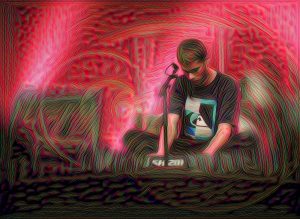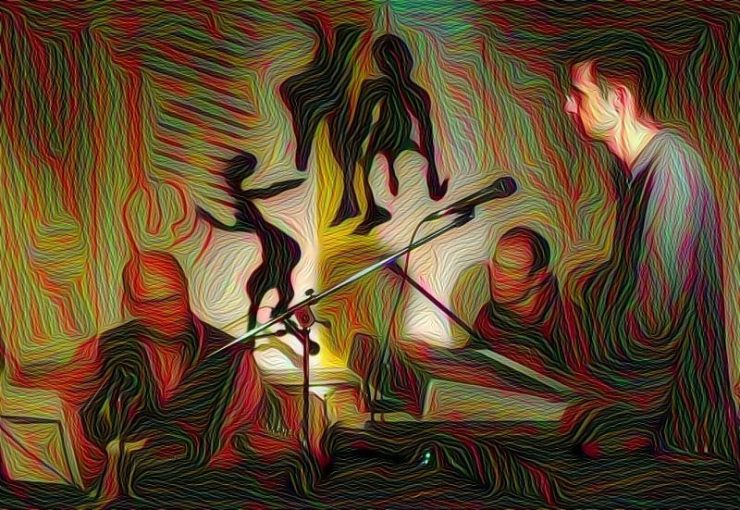Is there such a thing as meditation music and meditation concerts?
In a way music is always contemplative. Music brings us in touch with layers of life and being that are not so available in other modes of life, busy with practical external goals and standards. It uses sound, even the voice, but without the constraints of syntax and semantics sound is allowed to be exploring and expressing more directly – and in a very present, embodied way – what is alive in the awake in the “present” (whatever that exactly means – let’s explore this another time soon). So you might say all music and all concert is meditation.
Perhaps the idea of “meditation music” is just lazy or incompetent musicians’ pretense for playing very elementary stuff? For some “meditation musicians” including myself, such a criticism would be completely fair. But there are also real competent musicians, including those that I have the great luck of playing with sometimes, who are very good at playing other kinds of music as well, and able to shift into a particularly meditative mode of playing – simple, intuitive, minimal and intense.
So yes, I think there is meditation music – in the relative sense of more care for the omnipresent meditative dimension – although there may be no meditation musicians.
What makes a musical performance meditative? Meditation may not really be captured in any list of procedures and definitions, but I think it is possible to identify some features that are typically there, features that it can be very helpful to cultivate or invite – and for meditative band members to remind each other:
- The framing – the very idea and announcement that this is a meditation concert. The mere fact that a group has come to participate in something announced as meditative sets a meditative dynamic working already, or better perhaps, it allows for undercurrents of mindfulness that were always there to be a little bit more in front, and a little bit more shared. It can be helpful to frame the arrival and first moves in a way that makes space for this, e.g. in a welcome remark directly addressing that we are already meditating together, perhaps inviting other engagements and devices to be gently set on pause.
- Generous care – invest in easygoing sensual background, in some visible and generous way, to support the framing. You can’t control all circumstances and it is far from necessary, but it is helpful to make some obvious detail a token of care. Special light, a beautiful drone sound as people walk in, or even just greeting people individually.
- Steadiness – demonstrative acceptance of things that may superficially seem to be disturbances or fallouts. They are not, they are part of the process,
- Pauses and minimality – It is well known that the pause is essential to music in general, but even more so in meditation music. Not surprising, as meditation is itself our pausing from all the trying to get somewhere, accomplish something, be something. Also the meditative-musical pause allows for the things that DO move and happen in the music to fully sink in and be appreciated in all their sensual quality and detailed timing. Minimality is almost the same as the pause but in a generalized form – not only about being quiet in the direct sense of sound volume, it also includes silencing the tendency to make variations or new patterns all the time. Fully inhabiting what is there rather than going somewhere else all the time. A kind of “second order silence” – and just like silence of the first order, the point is to be soft and inclusive rather than hard and unwavering.

- Love of detail. This one is almost just stressing an implication of the previous point, but that may be the case all the way through this list. With the more pausing and minimal playing, the fine details of notes, intervals, intonation etc can stand out and be contemplated in all their usually hidden richness. Also, standing in a more open space, the play of their web of meanings – very probably, no certainly, a play between musicians and listeners – can go much further.
- Openness to reinterpretation – contemplative group dynamics. I lack better words for this very unique quality – a quality that I tend more and more to see as the secret heart of a truly meditative concert. It is a particular kind of golden moment, sometimes beautifully long, where some pattern of experience and expression is ebbing out, and it is totally open and unclear what happens next. At this point it is incredibly valuable if the entire band – and inspired by it, the audicence – can hold the breath, at least in a figurative sense, not rushing to fill in with some well known groove or tune or attitude, including that of forcefully held silence. This is where the group is fully awake together, and where amazing new universes can emerge – somethimes carrying with them profound reinterpretations of what we are really doing here, what we are looking for, what the criteria of success are…
- Dialogue with audience and situation – be aware of what moves not just in yourself and the band, but in the room and the group, and give voice and rhythm to that. This makes for a shared emergence of modes of meditative experience, rather than just one-way communication of what the band is able to cook in their own little pot.
This is work in process, I think. Is there anything important i forgot in this list? Probably! Musician and listener friends, you are very welcome to fill in!
Many of these points are not so special to meditative music – but really apply to meditation processes and events more broadly. This is a good sign that we may be on the right track in characterizing meditation music. Also some of the points may represent ways that experience from meditation concerts can be used to inform and inspire other kinds of work in groups – for me, this is particularly true of the mysterious point 6.
Wording: “Contemplation concerts” may actually be a more fitting word. Contemplation is the open gaze, the listening into what is there. THEORIA, the Greek word translated into latin CONTEMPLATIO would be even better – the gaze of the god or gods. But I am afraid an announcement of “Theoretical Concert” might not sell so well.

[Pictures are photos from Moving Meditation and Surrender Cowboys events, and from a solo meditation concert by my son Asbjørn Elle, all of them tweaked with “Dream Generator” software]
